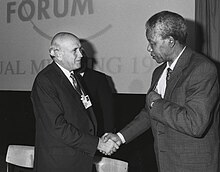Nelson Mandela’s 8 rules of leadership
 The former president of South Africa who ended apartheid there, Nelson Mandela, has an African first name, Rolihlahla, which translates literally as “pulling down a tree branch.” What that actually means is “troublemaker.”
The former president of South Africa who ended apartheid there, Nelson Mandela, has an African first name, Rolihlahla, which translates literally as “pulling down a tree branch.” What that actually means is “troublemaker.”
Mandela’s life means many more things: warrior, activist and statesman.
Here are his rules of leadership:
- Courage means surpassing fear. When his tiny plane lost an engine 20 minutes from its destination, Mandela sat calmly reading his newspaper. Once on the ground, he said, “Man, I was terrified up there!” He later explained that actual fearlessness would have been irrational, but as a leader he couldn’t show fear.
- Lead from the front … but people must follow. After decades of armed struggle and refusing to negotiate with the government, Mandela decided to start talking with his enemies. His allies thought he was selling out, but he brought them along.
- Lead from the back, too. As a boy, Mandela herded cattle. “You know,” he said, “you can only lead them from behind.”
- Know your enemies. Mandela tried to understand and engage his opponents. He studied Afrikaans, the language of white South Africans, to learn their worldview. While in prison, Mandela, who was a lawyer, helped wardens with their legal problems. It amazed those most brutal proponents of apartheid that he would help them. For Mandela, he realize
 d he could handle the worst characters imaginable.
d he could handle the worst characters imaginable. - Keep them close. Like Abraham Lincoln, the prisoner kept in his brain trust the people whom he didn’t like and couldn’t rely on. After his release, he called them on their birthdays and attended their family funerals. People simply act in their own self-interest.
- Dress the part. He maintained the appearance of a leader.
- Live in the gray area. He understood that apartheid had many causes and required nuanced solutions.
- Recognize when to quit. Once, Mandela tried to get the voting age lowered to 14. His effort failed and he accepted it without sulking. He also left office at the right time, knowing that leaders choose not only what to do but what not to do.
—Adapted from “Mandela: His 8 Lessons of Leadership,” Richard Stengel, Time.
Photos: Mandella in 2008 by South Africa The Good News (www.sagoodnews.co.za); State President of South Africa Frederik de Klerk and Nelson Mandela shaking hands at the Annual Meeting of the World Economic Forum, copyright 1992, World Economic Forum.






